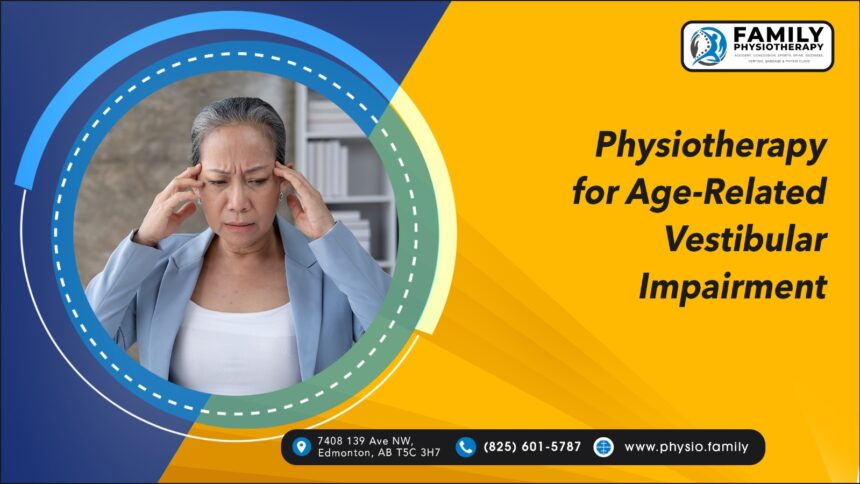Vestibular physiotherapy is aimed at treating balance disorders and symptoms associated with dysfunction of the vestibular system. Vestibular physiotherapy in Edmonton involves exercises and maneuvers designed to promote compensation for vestibular deficits, reduce symptoms, and improve overall balance and function. The goal of vestibular physiotherapy is to help patients regain their balance and mitigate the impact of vestibular dysfunction on their daily lives.
How Physiotherapy Helps for Age-Related Vestibular Impairment:
Physiotherapy can play a vast role in managing age-related vestibular impairment, which often manifests as dizziness, imbalance, and vertigo due to changes in the vestibular system associated with aging. Here’s how physiotherapy helps:
Vestibular Rehabilitation Exercises:
Physiotherapists design specific exercises to improve vestibular function, balance, and gaze stability. Vestibular rehab exercises typically involve head movements, eye exercises, and balance training to retrain the brain to interpret signals from the vestibular system more effectively.
Gaze Stability Exercises:
These exercises aim to improve the capability to sustain focus on a stationary object while the head is moving. Examples include:
- Visual Fixation: Focusing on a stationary object while moving the head side to side, up and down, or in circles.
- Gaze Stabilization: Fixing gaze on a target while performing head movements, such as turning the head side to side or nodding up and down.
Sensory Integration Exercises:
These exercises help improve the brain’s ability to integrate information from different sensory systems. Examples include:
- Visual-Vestibular Integration: Performing head movements while focusing on a moving target to improve coordination between visual and vestibular inputs.
Gait and Balance Training:
Physiotherapists focus on improving walking patterns and balance control to reduce the risk of falls, which is often increased in individuals with vestibular disorder. This may include practicing various balance exercises and techniques to enhance stability during walking.
Gait Training:
- Tandem walking: Patients walk heel-to-toe in a straight line to improve balance and coordination.
- Side-stepping: Patients step sideways to improve lateral balance control.
Dynamic Balance Exercises:
- Walking on different surfaces: Patients walk on various surfaces, such as foam pads, uneven terrain, or balance beams, to challenge their balance control.
- Obstacle courses: Patients navigate through obstacles while walking to improve balance and coordination.
Compensatory Strategies:
Vestibular physiotherapy in Edmonton teaches patients compensatory strategies to manage symptoms and adapt to vestibular deficits. This may involve techniques such as using visual cues to maintain balance or modifying daily activities to minimize dizziness and vertigo episodes.
Visual Compensation:
- Visual Focus: Encouraging patients to focus on stable visual references such as fixed points in the environment or stationary objects when feeling dizzy or unsteady.
- Use of Visual Cues: Placing contrasting visual cues on the floor or walls to provide spatial orientation and improve balance during activities like walking or reaching.
Activity Modification:
- Pacing Activities: Breaking down tasks into smaller, more manageable segments and allowing for frequent rest breaks to prevent fatigue and minimize symptoms.
- Avoiding Triggers: Identifying and avoiding activities or environmental factors that trigger dizziness or vertigo episodes, such as rapid head movements or crowded, visually stimulating environments.
Fall Prevention:
Physiotherapists assess fall risk factors and develop personalized fall prevention strategies tailored to the individual’s needs. This may involve strengthening exercises, home safety assessments, and recommendations for assistive devices or modifications to the environment to reduce fall hazards.
Strengthening Exercises:
- Lower Extremity Strengthening: Targeting muscles of the legs and hips to improve balance, stability, and mobility.
- Core Strengthening: Strengthening the muscles of the abdomen and lower back to improve posture and stability during standing and walking.
Assistive Devices:
- Recommending and instructing patients in the use of assistive devices such as canes, walkers, or mobility aids to improve stability and prevent falls.
- Ensuring proper fit and usage of assistive devices to maximize effectiveness and safety.
Progressive Treatment:
Physiotherapy for age-related vestibular impairment is often a progressive process, with treatment plans tailored to the patient’s specific symptoms, goals, and progress. As the patient improves, the physiotherapist may adjust the exercises and interventions accordingly to continue maximizing functional outcomes.
Functional Progression:
- Focusing on improving functional outcomes and enhancing participation in activities of daily living (ADLs) as treatment progresses.
- Incorporating task-specific training and simulation of real-world activities to promote the generalization of skills to everyday life.
Education and Lifestyle Modifications:
Physiotherapists educate patients about their condition and provide guidance on lifestyle modifications to reduce symptoms and improve overall quality of life. This may include advice on proper hydration, diet, sleep habits, and avoiding triggers that exacerbate vestibular symptoms.
Hydration and Diet:
- Advising patients on the importance of staying well-hydrated to maintain optimal vestibular function and prevent dehydration-related symptoms like dizziness.
Sleep Hygiene:
- Discussing the importance of good sleep hygiene practices, like establishing a consistent sleep schedule, crafting a comfortable sleep environment, and avoiding caffeine and electronics before bedtime.
Stress Management:
- Stress-reduction techniques, such as relaxation exercises, deep breathing, or mindfulness meditation, help patients manage anxiety and stress, which can exacerbate vestibular symptoms.
Empowering Independence:
Vestibular physiotherapy in Edmonton stands as a cornerstone in the management of age-related vestibular impairment, offering a multifaceted approach to tackle the intricate challenges associated with this condition. By continuously adapting treatment plans to accommodate each patient’s unique needs and goals, Family Physiotherapy fosters ongoing improvement and functional outcomes. Furthermore, by empowering patients with lifestyle modifications and self-management techniques, vestibular physical therapy not only alleviates symptoms but also promotes long-term symptom control and enhances overall quality of life. With its holistic approach and patient-centred focus, geriatric physiotherapy serves as a crucial ally in enabling individuals affected by age-related vestibular impairment to reclaim independence, mobility, and well-being.


